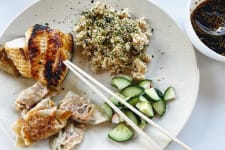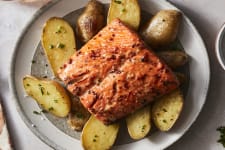Having the right fats in your kitchen and understanding how to use them in your wild-caught seafood meals is what will set you apart from other home cooks, equipping you with the most essential components you need to cook like a pro.
Knowing which oils to buy and when it makes sense to use them can make all the difference across a spectrum of culinary uses, whether you’re frying, searing, poaching, drizzling or dressing wild-caught seafood.
Starting from the most technically versatile fats and down to the most specialized, here’s your master guide on using fats to get the most out of your wild-caught seafood.
Neutral Cooking Oils
You should have a neutral oil with a high smoke point in your pantry at all times for the sake of culinary versatility. A neutral oil that can withstand high heat is indispensable for cooking your seafood on the stovetop, whether you’re going for a straightforward sear or are frying up something battered or breaded.
Refined avocado oil, ghee, and newer alternatives like algae oil are excellent choices for this, as they won’t break down in high-heat situations and are readily accessible. Refined coconut oil (as opposed to virgin or raw oil) also has a high smoke point and is neutral in flavor, making it another good option for high-heat recipes.
A Tale of Two Olive Oils
Even though you can use a neutral oil for practically any cooking method — it will get the job done, no matter what — you ought to have a bottle of mid-range extra virgin olive oil on hand, and perhaps a high-end one as well. However, if you only want one bottle of olive oil in your pantry, definitely opt for the mid-range oil as it can be used either raw or heated.
A mid-range olive oil is ideal for oil poaching or pan-searing when you want your seafood to pick up that unmistakable flavor of the Mediterranean. A mid-range oil is also going to be the base of many marinades, whether your seafood is going to end up in the oven, on the stovetop, or on the grill, so you really want to make sure that it’s an oil that tastes good. In contrast, cheap extra-virgin olive oils are bland, practically neutral in flavor, and oftentimes are blended with other oils.
As for high-end extra virgin olive oil, you will want to invest in a bottle if you’re looking to get the most out of your wild-caught seafood. A high-end oil is what you will use to finish any recipes that would benefit from a drizzle of nutty, floral, or spicy notes right before serving. A high-end oil is also ideal for use in sauces that are served raw — such as a chimichurri, pesto, or chermoula — since its flavor will be the difference between a decent sauce and a divine one.
The Transformative Potential of Butter
Of all the fats you might have in the kitchen, butter has the lowest smoke point of all. You can use it to cook your seafood on the stovetop as long as you don’t have the heat up too high, which makes butter poaching over medium-low heat an optimal cooking method.
While you could certainly crank things up to medium to pan-fry rather than poach your seafood in butter, your pan isn’t going to be hot enough for either fish or shellfish to develop a nice golden crust — and definitely won’t be hot enough to get crispy skin. If crisp skin is your goal, check out our blog post on how to achieve the perfect, crispy wild salmon skin for some tips.
There are a couple of other things you can do with butter to make the most out of your wild-caught seafood. For one, you can easily make brown butter over medium-low heat to serve as a delicious sauce that goes well with basically everything. The Kitchn has an easy guide to walk you through how to make brown butter without burning it.
You could also buy — or make — clarified butter or ghee. In the process of making clarified butter, some of the most heat-sensitive solids are removed along the way, helping to raise the smoke point of the fat so that you can actually use it for high-heat scenarios without burning the butter. Sear away!
Miscellaneous Raw Oils for the Ultimate Flavor Definition
There’s a plethora of raw, unrefined and cold-pressed oils on the grocery store shelves that you might want to have in your culinary arsenal. Generally speaking, the less refined the oil, the lower the smoke point. Some of these shouldn’t be cooked whatsoever lest they lose their character.
That doesn’t mean they’re less useful, of course. These oils typically pack so much flavor that they can define a dish. Toasted sesame oil, for instance, should never hit the heat; it’s been pressed from toasted seeds already anyway, and will give any recipe a nutty flourish when it’s drizzled on top before serving. Other oils like raw coconut oil should be limited to low-heat processes — perhaps to sauté onions and ginger for a seafood curry, rather than to cook the seafood itself.
Keep in mind that raw oils often are best kept in refrigeration, having a shorter shelf life (raw coconut oil is one of the exceptions) that can have them going rancid sooner than you’d expect — so store them properly and don’t buy more than you think you can use in, let’s say, six months.
Have fun and get creative in the kitchen, allowing yourself to discover how it best works to complement the overall flavors in your meal.






